. . .
SATURDAY
JUNE 16 - 2018 Portsdown Hill
Ros Norton reported
today's walk by the Friends of Wildlife group. Photos
by Caroline French and Derek Mills
A group of nine
met on a cloudy and breezy morning to walk around the
Fort Purbrook area.
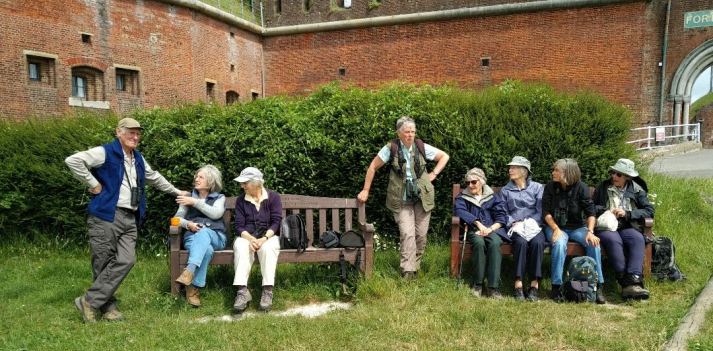
Highlights were as
follows Marbled White - Ringlet - Robin's Pin cushion
- Knapweed Broomrape
For full report go to
. . . Reports
. . . 2018
Foxgloves
Jill Stanley
went to see the Foxgloves at Stansted. What a sight
they were and the number must have been into the
thousands! They are in an area where dense coniferous
trees have been cleared for new planting. Jill thinks
the extra light has been beneficial to them.

FRIDAY
JUNE 15 - 2018
Hollybank
Woods
It was a
splendid morning for a walk through this local
woodland to the north of Emsworth. This was, in fact,
my first visit since Feb 16. Entering via the north
entrance on Emsworth Common Road I walked down the
main path where I met and had a nice chat with the two
main stalwarts of the woods, namely Andy Brook and
young Andrew. They were working on some huge piles of
wood chippings which had been left for them by local
tree surgeon Mike Reed. The chippings would be mostly
used for wildlife habitat, some for paths and some as
mulch for young trees. Here is a shot of young Andrew
filling up bags with wood chippings for use elsewhere
on the site.

Andy filled me in a
bit about the wildlife news. The resident pair of
Goshawks was regularly seen, but was not nesting as
far as they knew. Two pairs of Buzzards were nesting
on Longcopse Hill. No sign as yet of White Admirals,
but it is a bit early for them.
I walked round the old
circular path through the western section of the
woods, though all the signs have gone. I then went
through the east section as far as my favourite
Lorton's seat where I had a welcome rest and posed for
a selfie.

Here is a short video
clip of my view from the Lorton seat . . .
https://youtu.be/RWVa23GwG7Q
There was not much
bird song this morning apart from the ubiquitious
Blackbird and an occasional Song Thrush. There were
few butterflies during the walk, but I was pleased to
see and get a photo of my first Large Skipper
of the year (though I did catch a quick glimpse of one
on Brook Meadow yesterday).

I always enjoy seeing
the delightfully named Enchanter's Nightshade
along the paths in Hollybank Woods - and here is one I
managed to get in focus.

New plants I noted in
flower included Foxgloves, Marsh Thistle and
Honeysuckle plus a patch of what looked like
Dense-headed Heath Wood-rush (Luzula
multiflora ssp congesta) which I have recorded
several times in Hollybank Woods in the past. See
photo below - lower right. I suppose it could be the
more common Field Wood-rush?
I noted several
grasses, including my first Creeping Bent of the year,
with typically closed panicles. There was masses of
Remote Sedge along the paths.
I also found
Soft Rush (left - with soft unridged stems) and
Compact Rush (right - with tight
inforescence)
Hedgehog
news
Caroline
French still sees Hedgehogs in her North Emsworth
garden. She recently counted four adults in the garden
at one time but expects more individuals pass through
unseen. A couple of weeks back Caroline found a female
out in the daytime so she took it to Brent Lodge
Wildlife Hospital. Happily she was fine. They thought
it quite likely she was heavily pregnant, so Caroline
is hoping to see youngsters soon.
Here is a photo
by Caroline of young Hedgehogs in her garden taken in
August 2015.

Caroline notes that
Pat Morris has a new New Naturalist title called
'Hedgehogs' due for release on 28th June.
THURSDAY
JUNE 14 - 2018
Stag
Beetles
Stag Beetles
are fairly common, but Chris Oakley had a Lesser Stag
Beetle in his garden today, which is not all that
common. In fact, I do not recall ever having seen one.
The Lesser Stag Beetle is quite different from the
male Stag Beetle which is much larger and has
substantial stag-like horns. However, the Lesser Stag
is not easy to distinguish from the female Stag
Beetle. It is a bit smaller, but is always uniformly
grey-black in colour, whereas the female Stag tends to
have chestnut brown wing cases. The two also appear to
have slightly different patterns of head and thorax as
shown in these photos.
Here are the two
compared with Chris's Lesser Stag Beetle on the
left
and a female Stag Beetle that I had in my
garden a couple of years ago on the right.
Here is a male Stag
Beetle for comparison (taken by Caroline
French)

WEDNESDAY
JUNE 13 - 2018
Hayling
Oysterbeds update
Christopher
Evans visited Hayling Oysterbeds this afternoon and
happened to meet Wez Smith (RSPB Warden) who was just
about to row over to the Tern raft. Wez said there are
30 Common Tern nests on the raft and the chicks
are just starting to hatch. He said they have also
added a second, much smaller, raft. Terns out in the
harbour are generally doing well but there are a
couple of high tides due shortly which could affect
them.
Walking down the
Hayling Billy Line Christopher watched a large bird of
prey out over Langstone Harbour being mobbed by gulls.
It wasn't a Buzzard or Red Kite, so he wondered if it
could have been an Osprey. This seems unlikely as
Ospreys are usually passage birds in our region being
seen from Mar-May and again from Aug-Oct, but you
never know. Birds of Hampshire does indicate that a
few sightings are made from late May into June which
are presumed to be young non-breeding birds making
their first migration.
TUESDAY
JUNE 12 - 2018
Brook
Meadow
I had a wander
through the meadow this afternoon, mainly looking for
grasses missing from this year's list, such as Meadow
Barley and Smooth Brome. I pushed my way through the
head high vegetation on the centre meadow but could
see no sign of them. Everything is so rampant on the
meadow that finding scarce grasses is well nigh
impossible.
However, I was pleased to located another patch of
Smooth Tare that has somehow managed to survive
in the jungle. Smooth Tare can be distinguished from
Hairy Tare by the following features: it is hairless
with fewer flowers (1-2) and fewer leaflets (3-6);
sepal teeth are unequal and pods contain four seeds
(Hairy Tare has only two). Here is today's plant
showing two flowers.

I did find the first
flower of Common Knapweed on the Lumley area
along with lots of Sharp-flowered Rush.
I found another one of
those wolf spiders that I found yesterday called
Pardosa amentata and from today's photo
one can clearly see tha this one is carrying its egg
sac at the rear.

I arrived just as a
couple of chaps from Norse were finishing cutting and
clearing the main paths. The paths have been cut much
wider than in previous years and look a bit like
mini-motorways! The cuttings had been blown off the
gravel path. But no lasting harm has been done and
everything will grow again.

Two jolly fellows from
Norse.
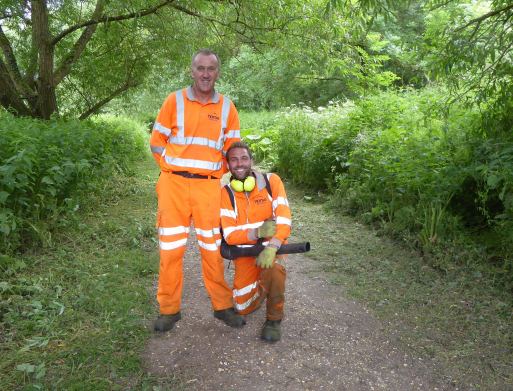
Langstone
Mill Pond
Peter
Milinets-Raby says the last two days have been very
quiet down Langstone Mill Pond. The highlights have
been;
31 Little Egret chicks (amazingly all at roughly the
same size) with a minimum of 4 adults. Only about 15
nests now visible. The rest of the adults are
obviously out collecting food for the hungry horde.
The Grey Herons are difficult to see, but the pair on
top of the Holm Oak are clearly sitting on a second
brood.
Two pairs of Tufted Duck were present - only a matter
of days before the first ducklings appear. The Cetti"s
Warbler is still singing occasionally and only one
Reed Warbler is in full song.
Off shore 4 Great Crested Grebe, 4 Common Tern and 2
Shelduck.
The two female Mallard still have their ducklings and
the Mute Swan pair are very disinterested in
breeding.
MONDAY
JUNE 11 - 2018
Brook
Meadow
I had a short
walk around the northern section of Brook Meadow this
morning. I started at the Seagull Lane patch where I
found a very nice display of the delicate hanging
spikelets of Barren Brome grass - the best on the
meadow. What a lovely grass.

Also on this patch the
white trumpets of Large Bindweed are starting
to open, displaying their distinctive overlapping
bracts beneath the white flowers.
I had a look around
the orchid area where the orchids are in sharp decline
and are being progressively engulfed by tall grasses
and bindweed. The 3 Bee Orchids are still
visible, just, and Jennifer's original by the tall
stick now has three flowers.

I am always pleased to
discover Meadow Fescue (Festuca
pratensis) which can bee seen very well on the
edge of the path near Beryl's seat, both to the south
of the seat and opposite the seat.

Meadow Fescue is
fairly easy to pick out from the more abundant Tall
Fescue by its well spaced spikelets on the
inflorescence. The best feature to look for is the
fact that the panicle branches mostly arise singly or,
if paired, have only one spikelet on the shorter
branch of each pair - as shown in this photo below
taken today. I have yet to find the Hybrid Fescue
xFestulolium loliaceum which is a hybrid of Meadow
Fescue and Perennial Ryegrass which usually occurs
with the two parents.

Just after checking
out the Meadow Fescue, I met Maurice Lillie who had
the power scythe out cutting the western path through
the north meadow. I warned him to look out for the
Meadow Fescue near Beryl's seat which, by chance, he
had just avoided!
As for insects, I
noticed many grasshoppers jumping around in the long
grasses, but this was the only one that stopped long
enough for a photo. From the long antennae it is
clearly a Bush-cricket and the hint of a green stripe
around the pronotal flap suggests a Roesel's
Bush-cricket, though I welcome other views.

Maurice was with me
when we spotted this Nursery-web spider
(Pisaura mirabilis) nursery nest of
spiderlings deep in the long grasses. The adult mother
spider was lurking behind the nest and her legs are
just visible at the top of the photo. I am not sure
what the white object is. Part of the web construction
or a prey?

Another spider that I
am not entirely sure about, but will hazard a guess at
Pardosa amentata which I previously saw
on the meadow at this time last year. This is a wolf
spider that carries its egg-sac at the rear.

Friends
of Nore Barn Woods
I have just
received the June 2018 Newsletter produced by the Nore
Barn group which contains information about workdays,
wildlife, etc, plus several photos of the volunteers
at work. If you wish to help out and/or support the
group who are doing a fine job then contact Roy Ewing
at . . . royewing1@gmail.com - Their web site is at .
. . http://www.norebarnwoods.org.uk
Here are some of
the Nore Barn volunteers looking for orchids
- and they found some - Southern Marsh Orchids!

SUNDAY
JUNE 10 - 2018
Indoor
Damselfly
I was
surprised to find a male Blue-tailed Damselfly
resting on the inside of our kitchen window which was
closed at the time. After taking a photo I opened the
window to let it out, but it stubbornly stayed put for
almost an hour before flying off. The nearest water is
the Westbrook Stream which runs along at the bottom of
the garden, though my damselfly guide stresses that
this species may be seen almost anywhere, even at a
long distance from water.

Fort
Widley
Jean and I had
a nice picnic lunch on top of Portsdown Hill looking
north across the fields towards Purbrook Heath after
which we walked round Fort Widley. We struggled at
times in the heat, but it was worth it for the
glorious array of wild flowers that was on
display.
Although Fort Widley is never quite up to Fort
Purbrook for orchids, we did see good numbers of
Common Spotted and Pyramidal Orchids. Common
Spotted Orchids were mostly behind the fort and
varied in colour from bright pink to almost white.
Pyramidal
Orchids were mostly on the path below the
fort.
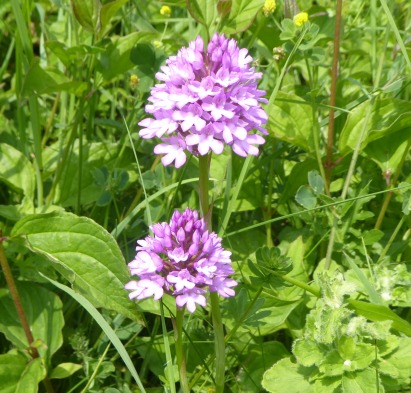
Knapweed
Broomrape was everywhere along the path below the
fort nearest to the road. I gave up counting when I
got to 50. Here is a nice cluster of three spikes. If
you looked closely you could just make out their
yellow flowers.
Other flowering plants
not seen before included Bladder Campion, White
Campion, Agrimony, Tufted Vetch, Wild Mignonette,
Restharrow, Hoary Plantain and Greater Knapweed plus
some superb Goat's-beard seedheads.
Wild Thyme was
prominent on the grass slope west of the fort.
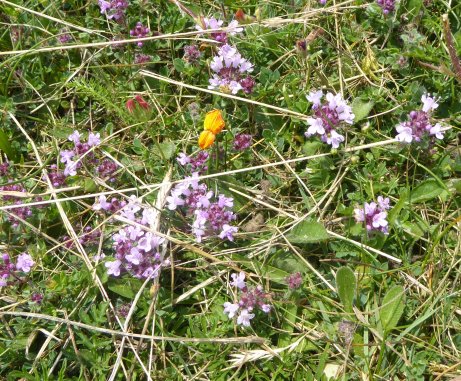
I always look forward
to see Upright Brome grass on Portsdown swaying gently
in the breeze. Quaking Grass was also present, though
less prominent.
Lots of Meadow Browns were fluttering around
over the grasses around the fort along with a few
Common Blues. A Yellowhammer was singing its
'little bit of bread with no cheese' song from behind
the fort.
FRIDAY
JUNE 8 - 2018
Brook
Meadow
I had an
e-mail from Jennifer Rye last night to say she had
discovered a second Bee Orchid in the orchid
area of the north meadow about 10 yards to the south
of the first one (marked with a tall stick).
Jennifer's new one was easy to find as she had marked
it with a forked stick. The first one now has two
flowers on the spike with another couple still to
come, as shown in this photo taken on site.

While taking this
photo I noticed yet another Bee Orchid right next to
the original one, which makes a total of 3 so far this
year for Brook Meadow. There must be others which are
just invisible beneath the welter of grasses and
Bindweed.
The Southern Marsh and Common Orchids are still
prominent but are becoming progressively engulfed by
Bindweed which now dominates the orchid area. However,
this super Common Spotted Orchid defied all
comers.

Less spectacular, but
equally important in the big scheme of things is the
Hard Rush

Almost as fine as an
orchid is Hedge Woundwort which is now is in
flower near the Lumley area.

The first white
trumpets of Hedge Bindweed are now out on the Lumley
area.
You can see a gap in the bracts covering the sepals
which would not be there in Large Bindweed.

Leaves of
Gipsywort are fairly prominent below the south
bridge (south side).
I usually find plenty on the west bank in Palmer's
Road Copse.
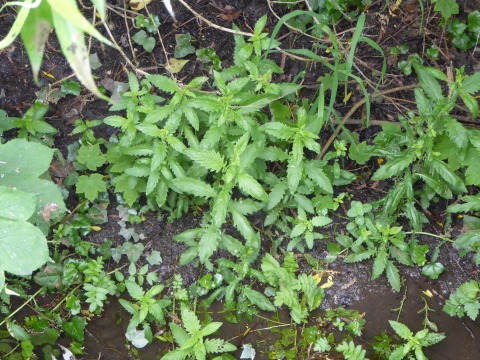
I still have not found
any Meadow Barley or Smooth Brome that I found on
Fishbourne Meadows yesterday.
Bridge
Road Wayside
Walking home
through Bridge Road car park as is my custom I was
delighted to come across a good growth of Crested
Dog's-tail - another grass that I have not been
able to find on Brook Meadow.

Another interesting
observation was a large plant of Hemlock
Water-dropwort that had completely collapsed under
its own weight. This frequently happens to Hemlock
Water-dropwort plants on Brook Meadow.

More
Bee Orchids
I was pleased
to hear from Jennifer Rye who checked the Bee Orchids
on the grass verge near the Warblington roundabout
today. I have been putting it off as it involves
crossing the busy main road. Jennifer found between
20-30 flowering Bee Orchid spikes on the uncut part of
the verge near the hedge. This is a good number, but
well down on the 60+ I found at this time last year.
Maybe it would be best to remove the 'do not cut'
notice that I put on the verge a couple of years ago
as cutting the grass might help the orchids to
grow?
Ann Moodie spotted two Bee Orchids in flower on the
grass verge near the pavement to the south of Peter
Pond. This is a new place for them.
Jill Stanley went hunting for Bee Orchids on the
Northney reserve and found 47 flowering spikes,
including this splendid specimen. Again, numbers are
down on last year when she had 70 in the same place.
Maybe they are having a poor year, though our Bee
Orchid counts on Brook Meadow do fluctuate from one
year to the next.

WEDNESDAY
JUNE 6 - 2018
Swifts
We had 6-7
Swifts flying low over the houses in Bridge Road
yesterday evening, the most we have seen so far this
year. Hoping for more.
Fishbourne
Meadows
I stopped off
at Fishbourne Meadows on the way home from my weekly
volunteering stint at the Pallant Gallery. I sauntered
round the main meadow, but did not venture any
further. Here is a view looking across the main
meadow. Grasses are growing like mad!

Fishbourne Meadows is
the closest in general habitat to Brook Meadow in our
local area and is worth a visit. It is managed and
maintained by the Friends of Chichester Harbour. It is
best accessed from the Fishbourne Parish Church car
park.

It has plenty of
Southern Marsh Orchids, but (as in Brook
Meadow) they are being overtaken by burgeoning
grasses. An annual orchid count is conducted, so I
will try to find out numbers. They usually have 500+.
Here are a few near the path.

There was not sign of
any Water Voles along the stream, though I did hear
Reed Warbler singing. This is the River Lavant which
runs through Chichester.

I am envious of the
Meadow Barley and the Smooth Brome that
grows well along the edge of the stream. I have found
neither on Brook Meadow so far this year. Here is a
clump of Meadow Barley by the stream.

My attention was
attracted by a clump of Yorkshire Fog with deep
red panicles and by the tall plants of Water
Figwort, now adorned with bright red flowers.
I encountered what I
assume was a pair of Common Blue butterflies,
one bright blue male and one brown form female.
Warblington
Bee Orchids
Roy Ewing had
a look for Bee Orchids on Brook Meadow but without
luck. The one that Jennifer Rye found at the weekend
is a devil to see when you don't know exactly where to
look.
However, not to be deterred, Roy then jumped on his
bike and found 3 Bee Orchid spikes on the Havant Road
grass verge near the Warblington roundabout. Maybe
there are more that Roy missed, for I counted 60+
flowering spikes at this time last year. Roy noted
that the notice warning the council mowers to avoid
cutting this area is still present, so they have not
been cut down. Maybe it is just a poor year for Bee
Orchids? Here is a photo of some of them that I took
last year.

MONDAY
JUNE 4 - 2018
Millpond
News
Yesterday Dan
Mortimer alerted me to the fact that 4 swan cygnets
were now on Peter Pond. So, I went down this
morning to have a look for myself and sure enough the
Mute Swan pair was swimming around happily on the pond
with four tiny cygnets.

Gosh, how they deserve
this outcome after the trauma they went through
earlier when their first nest with 8 eggs was washed
away by a high tide. They tried again with a higher
nest in the reedbeds and succeeded. Let's hope they
have learned to nest in the reedbeds next time.
Here is a short video clip I made of the family on the
pond . . . https://youtu.be/GtgQuJOnpC0
Meanwhile, over on
Slipper Millpond one of the Great Black-backed
Gulls was stationed on the southern nesting raft
with two well-grown chicks sheltering from the wind
behind vegetation. They did have three chicks to start
with but I am fairly sure there were just two on the
raft today. This has happened in previous years when
three chicks were hatched, but one was lost, probably
due to falling off the raft and drowning.

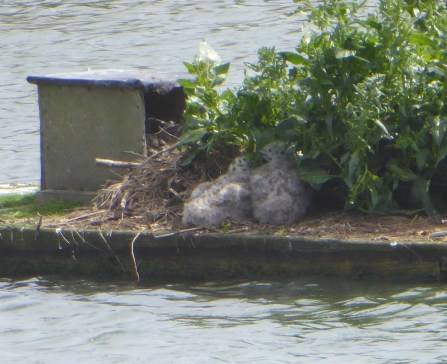
Coming back along the
path west of Slipper Millpond I stopped to admire the
wonderful growth of Sea Club-rush along the
edge of the pond.

This plant was
transplanted on Slipper Millpond from Peter Pond
several years ago by volunteers and has taken
remarkably well. Sea Club-rush (Scirpus
maritimus) is, in fact, classified as a sedge
despite its name.
Brook
Meadow news
On the way
home I had a little mooch around the south east corner
of the south meadow of Brook Meadow which was
remarkably dry considering the flooding of the River
Ems. Flooding in this area is affected by the tides
and not by the river. I was pleased I stopped as I
discovered very nice patches of Celery-leaved
Buttercup and and what I am fairly sure is
Hairy Buttercup - both of which have
disappeared from the nearby area by the Gooseberry
Cottage bund where they were so abundant in 2016.
I also noted Divided
Sedge and Sea Club-rush which are regular in
this area. Here is a close-up of a flowering spike of
Sea Club-rush with a typical extending bract. So far
this year we have recorded 14 out of the 15 sedges on
the Brook Meadow plant list.

There are some
magnificent stands of Yellow Iris (or Flag).
Here is one of the flowers showing the three spreading
flag-like petals.

Langstone
Mill Pond
Peter
Milinets-Raby had an extraordinary 50 minutes down at
Langstone Mill Pond today from 1pm - ducks were
everywhere!
On the pond were two broods of Mallard (a brood of 4
and another of 6 - with the Mute Swans not being as
aggressive as the old pair, these ducklings are
surviving well),
An amazing 3 pairs of Tufted Duck - There has been
just one pair for most of the month of May - One pair
was observed flying off the pond and seen to land in
the gardens of the Wade Court tower where there is a
small ornamental lake. I have always suspected that
this is where these birds breed, then bring their
ducklings along the stream to the pond).
Also on the pond were a pair of Gadwall - again they
left heading towards Wade Court? I might have to ask
permission to have an explore around the lake? It
would be exciting to get breeding Gadwall.
But the big surprise of the visit was a male Teal (my
first ever June record) - where this bird has come
from is anyone's guess?
Also on the pond were the two Mute Swans - I think
they have truly abandoned their nest.
2+ singing Reed Warbler.
I counted 11 Little Egrets nests with chicks, but to
be honest you can not see many more than this. The
pond seems empty this year, especially as the 11+
nests that are usually on the island are not there, so
very quiet indeed!
Out on the low tide trickle of water were 2 Little
Terns, a Great Crested Grebe and 9 Med
Gulls.
Ducks
in decline
The Wetland
Bird Survey 2016/17 report has been published and it
highlights the continuing declines in some duck
species, particularly Mallards with over-winter
numbers falling since the late 1980s. From Peter's
report, Langstone Mill Pond seems to be bucking the
trend!
The full results are here . . . https://bto-enews.org/NXK-5NN5H-3UEDCR-35ICQO-0/c.aspx
Nightingale
at Marlpit
Dave Perks
took the short trip up to Marlpit Lane just before
sunset yesterday evening in the hope of hearing a
Nightingale. To his delight, he heard one singing as
he walked along the footpath alongside the gravel
working to the east of the lane. Dave adds that even
though on a recent trip to Spain the Nightingale's
song was heard constantly it was a real thrill to hear
the bird so close to home.
SUNDAY
JUNE 3 - 2018
Brook
Meadow - Work session
I went over to
the meadow on a very warm and sunny morning for the
regular 1st Sunday in the month conservation work
session. Eight volunteers attended (plus one not in
the photo). The session was led by Maurice.

The main task involved
clearing the paths through Palmer's Road Copse and the
south meadow which had become very overgrown. I urged
the volunteers to try to avoid cutting interesting and
attractive plants, though this was not always easy to
achieve. However, a good job was accomplished. Here is
a video clip of volunteers at work. https://youtu.be/dQFOz3UO1QI
The workers also did a
good job in trimming the Hawthorn hedge which was
obscuring the view of the river and the meadow from
the observation fence.

A full report of the
work session with more photos can be seen on the Brook
Meadow web site at . . . https://www.brookmeadow.org.uk/conservation-news/
Wildlife
observations
A pair of
Speckled Wood butterflies was chasing around in
Palmer's Road Copse. This is the best place on the
Brook Meadow site to see these attractive insects.
Several Beautiful Demoiselles were flying over the
river beneath the south bridge.

I was pleased to find
two tufts of Remote Sedge thankfully missed
during the clearance - one on the path through
Palmer's Road Copse near the bridge, and the other on
the main path through the south meadow just north of
the signcase.

Remote Sedge is an
attractive sedge with long sweeping bracts, fairly
common in woodland, but rare on Brook Meadow where I
have recorded it only in these two locations. That
takes the total number of sedges recorded on Brook
Meadow so far this year to 13. Just two more to go for
the complete list!
I also found some
Plicate Sweet-grass along the cleared path on
the east side of the south meadow adjacent to the
Gooseberry Cottage bund. This is the only place that
this attractive and distinctive grass grows on Brook
Meadow and I was pleased to see it had largely
survived the cutting. That takes the total number of
different grasses recorded on the Brook Meadow site so
far this year to 15. More to come!

At the end of the work
session Jennifer led several volunteers (including me)
to a location in the centre of the main orchid area
where, yesterday, she discovered the first Bee
Orchid of the year on Brook Meadow. This was a
remarkable find. deep in the long grass, so well
hidden that it was not at all easy to see the plant
even when pointed out to us! Where there is one there
must be others, but can we find them? We all had a
look around while we were there with no success, but
keep looking!
While we were looking
for Bee Orchids, Jennifer spotted a tiny colourful
moth fluttering around. I managed to get a quick photo
and it turned out to be a Mint Moth
(Pyrausta aurata). It is small but
distinctive moth having deep orange markings on
brown-purple forewings. It is referred to as the 'mint
moth' because of its liking for minty plants. They are
regular on Brook Meadow and I also see them in my
garden.

SATURDAY
JUNE 2 - 2018
Brook
Meadow
I went over to
the meadow this afternoon mainly to do a recount of
the orchids. Counting is now difficult as the flower
spikes are getting very hard to see as the grasses and
other vegetation burgeons over and around them.
Today's count was much the same as the last one on May
30th, so I think that will have to stand as the final
count this year: Southern Marsh Orchids = 102
and Common Spotted Orchids = 23.
Both these
orchids have seen a significant increase this year as
shown in the following charts
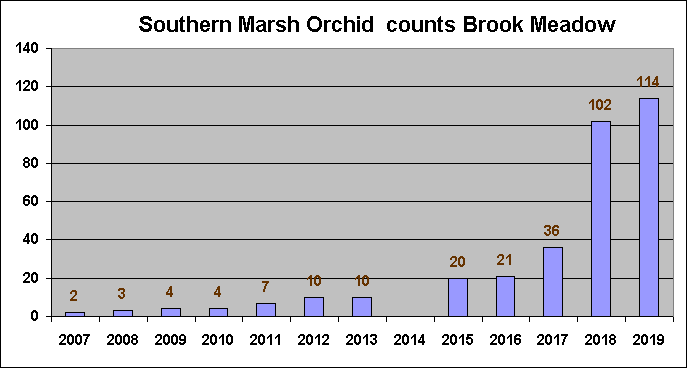
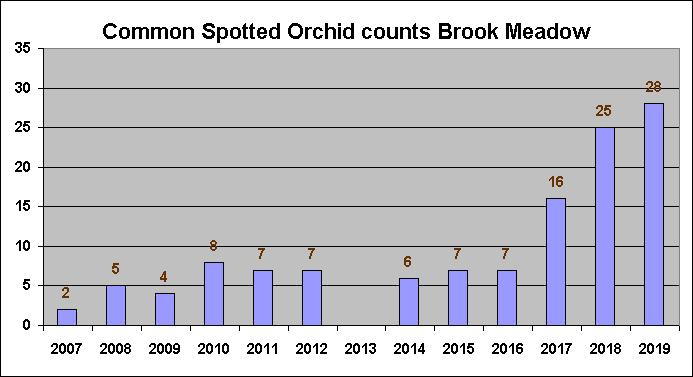
I looked for Bee
Orchids on the orchid area and the Lumley area,
but did not see any. There may well be some there, but
the grasses are so high and dense they would be well
nigh impossible to find.

I also searched for
Great Burnet which has been an interesting
feature on the orchid area since 2013. It should be
easily visible as it stands high well above most of
the grasses, but there was no sign of it at all. This
is not entirely surprising as numbers have been
falling in reecent years. In 2016 I counted 62
flowering Great Burnet plants, but last year I could
only find 10. This year there are none! This is what
it looked like in its prime a coule of years ago.

I found two nice
patches of Lesser Stitchwort in the usual spot
on the centre meadow just north of the causeway.

I had another three
new plants for this year alongside the casual doggie
path down to the Lumley Stream from the Lumley area:
Celery-leaved Buttercup, Brooklime and
Blue Water-speedwell. They were all rather
small and puny, but living!

There has been no sign
of Celery-leaved Buttercup in the south meadow near
the Gooseberry Cottage bund - where we had a glut in
2016. I expect we shall have more Blue Water-speedwell
over on the River Ems later in the summer.
Following my first
Common Blue of the year on a local wayside
yesterday, today I had my first one on Brook Meadow
but it did not stop for a photo.
While resting on the main seat overlooking the meadow,
I spotted my first Green-veined White of the
year fluttering around low in the grasses.

This takes the total
number of butterfly species recorded on Brook Meadow
this year to 11. Somewhat surprisingly, I have yet to
record Small Tortoiseshell. The Skippers and the
Browns will be out towards the end of this month.
Honeysuckle
Ralph Hollins
adds a comment about the Honeysuckle I found flowering
yesterday in the Beech hedge on Bridge Road.

He writes . . .
One
comment on your latest blog concerns the Honeysuckle
which you think may be a garden escape. This is
Japanese Honeysuckle which I find to be increasingly
common as a well established escape and easy to
distinguish from the normal Honeysuckle by its flowers
which appear in pairs with each pair of leaves along
the stem (as shown in your photo). Our normal
Honeysuckle has its flowers in a circular cluster at
the end of the stem. Stace gives the first report of
the Japanese species as being found in 1930 in South
Devon and I have regularly found it in this century
along the path running down the west end of Noar Barn
Woods and many other places.
FRIDAY
JUNE 1 - 2018
Waysides
News
I cycled and
walked around some of the local waysides this
morning.
There was nothing of special interest along the
Washington Road path apart from the song of a
Blackcap echoing through the underpass tunnel
under the A27 road. I thought at first the bird was in
the tunnel, but in fact it was singing from a bush at
the end. What a loud voice it had, drowning out the
traffic noise!
The large leaves of the Greater Burdock plants
are clearly visible by the pony field before the
Recreation Ground, but no flowers as yet.
My next stop was the grassland area immediately behind
bowling club which had a Whitethroat singing from the
bushes. There was a good growth of Buttercups and
grasses, including Smooth Meadow-grass, False
Oat-grass, Yorkshire Fog, Sweet Vernal Grass and
Crested Dog's-tail. I could not find any Bent grasses
as yet, but this is a reliable area for these delicate
and attractive grasses.

Other plants noted
included Cut-leaved Crane's-bill, Common Sorrel,
Lesser Stitchwort (my first), Field Wood-rush. I could
not see any Meadow Barley which usually see in the far
north west corner by the White Poplars.
On to Christopher Way
where I found about 20 Wild Clary plants, some
of which were in flower. Ralph Hollins found Wild
Clary in full flower in the only other reliable local
spot for this quite rare plant at the northern end of
the Hayling Billy line.
Wild Clary in
flower today on the Christopher Way verge

The Westbourne Open
Space is currently an impenetrable jungle of grasses,
fantastic for insects and other creepy crawlies, but
impossible for humans to cope with.

The small wayside at
the junction of New Brighton Road and Horndean Road is
far less intimidating. It was here that I saw my first
Common Blue butterfly of the year showing its clear
blue upper wings.

I did not go onto the
Railway Wayside, but just walked up the railway access
ramp from where I spotted a clump of bright blue
Love-in-a-Mist flowers, presumably from a seed
packet or someone's garden. From the ramp I also saw
my first Bindweed trumpet flower of the year. From the
two bracteoles which barely overlap beneath the white
flower, my guess it is Hedge Bindweed. In Large
Bindweed the bracteoles would be strongly inflated and
totally overlapping each other.
Back in Bridge Road I
noticed the tiny yellow flowers of Wall Lettuce
beneath the Beech hedge along the road by the car
park. Honeysuckle is also now in flower in this
hedge with white and yellow flowers - probably a
garden escape.
For
the previous month go to . . . May
1-31